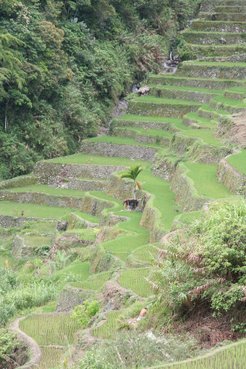International rice researchers take on world hunger
Maize could help to improve rice yield
Rice is the staple food for more than half of the world’s population. Thus, it is one of the most important crops in the world. Rice uses the C3 photosynthetic pathway, which is the more effective way of CO2 fixation in temperate climates. However, in hot dry environments it is not as efficient, and this is the very scenario which is expected to occur in many regions due to global climate change. Other plants, such as maize and sorghum, use the so called C4 pathway, which works more efficiently in adverse conditions. The researchers of the C4 Rice Project, led by Professor Jane Langdale of University of Oxford, believe that a switch from C3 to C4 could increase rice productivity by 50%.

A change in the photosynthesis strategy would first of all increase the photosynthetic efficiency in rice, resulting in improved energy gain which can be directly used for reproduction and with that for seed production. Moreover, the introduction of C4 is predicted to improve nitrogen use efficiency, double water use efficiency, and increase tolerance to high temperatures. This would make the rice plant well-adapted for future needs.
The principal investigator, Professor Jane Langdale, explained: “Land that currently provides enough rice to feed 27 people will need to support 43 people by 2050. In this context, rice yields need to increase by 50% over the next 35 years. Given that traditional breeding programs have hit a yield barrier, this goal does not seem achievable by traditional methods.”
In addition, rice yield is limited by its natural metabolic capacity. The reason for this is the inherent inefficiency of C3 photosynthesis. Notably, evolution surmounted this inefficiency through the establishment of the C4 photosynthetic pathway, and importantly it did so on multiple occasions in different plant species. This is the reason why researchers consider a switch from C3 to C4 in rice is a realistic goal.
Phases I and II of the programme were focused on identifying new components of the C4 pathway – both biochemical and morphological – as well as validating the functionality of known C4 enzymes in rice. The new Phase III of the project will refine the genetic toolkit that has been assembled and will focus both on understanding the regulatory mechanisms that establish the pathway in C4 plants and on engineering the pathway in rice.
In particular, the researchers at the MPI-MP will work with rice plants which already contain different enzymes of the C4 pathway. Professor Mark Stitt and his team will analyze plant compounds of both natural rice plants and engineered C4 rice plants. This comparison will be the first test for a successful integration of the C4 photosynthesis into rice and its use by the plant. “The engineered plants with new enzymes will use different compounds for photosynthesis, resulting in changed concentrations of these compounds in comparison to the control plants”, explains Dr. John Lunn, senior scientist at the MPI-MP.
Additionally, the researchers will examine the CO2 uptake rates of those plants and its fate. “This test allows us to check whether the new enzymes work in the rice plant and the C4 pathway is operational, and to what extent it replaces the endogenous C3”, describes Dr. John Lunn.
The C4 Rice Project was initiated in 2008 with funding from the Bill & Melinda Gates Foundation, following discussions led by IRRI. Phase III of the project is a collaboration between 12 institutions: Oxford University, IRRI, Cambridge University, Australian National University, Donald Danforth Plant Science Center, Washington State University, University of Minnesota, University of Toronto, Heinrich Heine University, Max Planck Institute of Plant Physiology, Academica Sinica, and the Chinese Academy of Sciences-Max Planck Partner Institute for Computational Biology. This phase has been funded by a grant of over 6.4 million Euros from the Bill & Melinda Gates Foundation.
